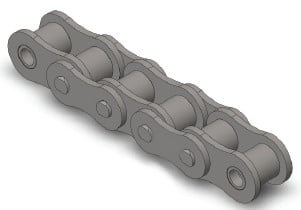Roller chains are one of the most productive and price eff ective ways to transmit mechanical electrical power between shafts. They operate more than a wide range of speeds, take care of massive working loads, have really smaller vitality losses and therefore are frequently cheap in contrast with other techniques
of transmitting power. Thriving assortment entails following a number of reasonably simple methods involving algebraic calculation along with the utilization of horsepower and support component tables.
For any offered set of drive problems, there are a variety of probable chain/sprocket confi gurations which will effectively operate. The designer thus should be conscious of various primary choice principles that when applied properly, assist balance overall drive effectiveness and cost. By following the methods outlined on this part designers ought to be in a position to create selections that meet the demands of your drive and therefore are price eff ective.
General Roller Chain Drive Principles
? The advisable number of teeth for the tiny sprocket is 15. The minimal is 9 teeth – smoother operation is obtained with more teeth.
? The advised maximum amount of teeth for your substantial sprocket is 120. Note that when much more teeth will allow for smoother operation getting too many teeth prospects to chain jumping off the sprocket after a fairly little level of chain elongation as a result of dress in – Which is chains that has a quite massive amount of teeth accommodate less put on in advance of the chain will no longer wrap all around them adequately.
? Speed ratios ought to be 7:one or significantly less (optimum) and never better
than ten:1. For more substantial ratios the usage of a number of chain reductions is recommended.
? The advisable minimal wrap of the little sprocket is 120°.
? The advised center distance concerning shafts is 30-50 pitches of chain. You will find two exceptions to this as follows:
1. The center distance have to be higher compared to the sum in the outdoors diameters from the driver and driven sprockets to prevent interference.
two. For pace ratios higher than three:1 the center distance shouldn’t be significantly less compared to the outside diameter on the large sprocket minus the  outside diameter with the compact sprocket to assure a minimum 120° wrap all around the compact sprocket.
outside diameter with the compact sprocket to assure a minimum 120° wrap all around the compact sprocket.
